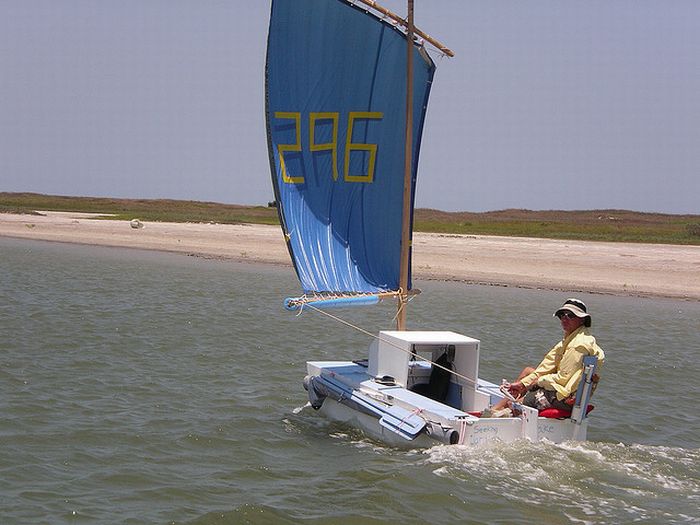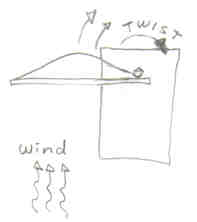Control Problems When Sailing In Light & Heavy Winds

Digging The Bow (& Submarining)
This can happen in just about any type of sailboat, it is caused by going fast and then clipping a wave which can cause the boat to try and dive under it.
Catamarans that go really fast have to be careful, because they are extra easy to trip which tends to throw the crew forward off the boat.
Some of the newer catamarans are designed with wave piercing bows so they have less of a tendancy to do this.
(the boat on the left is a Murray 41, and the right is an International 14)
I have submarined my puddle duck when I had BucketEars configured as a board boat. The wave I clipped washed over the entire boat.
I didn't capsize, but the cockpit was full of water and I had to bail it out.
After I switched back to a 16" high hull, I have not submarined since.

Texas 200 Seat &
Falling off the back of your boat
The Texas 200 is a 5 day trip along the Texas coast.
The winds usually blow from the same direction, which is from the stern of the course that is sailed, so it has been described as a "down hill sleigh ride".
For duckers that participate in that event, they often sit up on the stern corner to get the most power out of their sail.
Unfortunately, sometimes if startled by a dolphin, passing boat, or another ducker yelling at them to take their picture, they fall right off the back of their boat.
So if you end up in a similar situation, you might want to consider tieing yourself to your boat, so when you do fall off, your boat won't sail away from you.
Something I do is tie a loop in the end of the main sheet, and I put my hand in there.
It is loose enough that if I had to, I can slip my hand out.
A better solution would be to configure the duck so that you can sit inside the boat, in that stern corner.
 Rudder Stops Working, Can't Steer
Rudder Stops Working, Can't SteerWhen sailing in light winds (like up to 15 mph) the boat handles just fine, and is easy to control. After the wind gets stronger, you try to steer and she won't respond to the tiller, and will continue on a straight line.
Also related is a certain wind speed when you can go to windward just fine, but going down wind you can't go straight down wind -- you can only go about 30 degrees off directly down wind, in the opposite side that you have your sail.
What is happening here is that we have very short boats, the distance from the rudder to leeboard is very small. At the same time, we put a LARGE amount of sail up, like around 60+ sqft (most 8' boats have a much smaller amount of sail, like 35 sqft). The sail acts like a lever arm trying to pivot the entire hull around the leeboard. The rudder is the main thing counteracting that.
If you can setup your boat so the leeboard is in the middle, about 4 feet away from the rudder, it helps the situation a lot better. Also short fat sails (like the balanced lug) tend to have longer booms on them, so more sail area is hanging out there. Tall skinny sails like the mutton have less of this effect.
But all puddle ducks are different, and you need to tinker with your setup to figure out how to make it work. I had this problem on BucketEars when my leeboard was 3' from the stern, but moved it to 4' from the stern and the problem went away.
Can't go to windward in heavy winds
What happens is that the sails produce a certain amount of lifting force. That force increases with the wind speed in an uneven manner, so that they lift the best in a certain wind speed, and then the more wind you have, you only get a little bit more lift. The hull freeboard (the hull part above the water) produces drag as the wind blows on it. The drag seems to increase steadily as the wind speed increases.
So when the wind isn't blowing that hard, your lift can easily overcome the drag. As the wind picks up, you get more and more drag, but not so much more lift, and eventually the lift power of your sails can not overcome the drag of the hull, and you loose your ability to sail to windward. If you built a hull configuration with a cabin, it will have an even larger amount of drag -- so that is one of the compromises you have to think about.
Hulls that are 16" high seem to be a great compromise. Also if you want a cabin on your duck, you can easily make it a bolt-on type, so when racing you can leave it at home.
Trouble Tacking in Light Winds
Taking a sailboat is a bit of an art form. Lets say it is a light day, breath of air you are riding is just enough to pull you along. You are on a close haul (heading 45 degrees into the wind) and as you push the tiller over, you head up into the wind and stall out, unable to go in either direction, stuck in irons.
What has happened is that when you head into the wind, your boat picks up additional resistance and drops in speed at the same time, so you get stuck half way.
Trouble Tacking in Heavy Winds
You are sailing along at a great clip, the spray is flying and you are going so fast that your hair might spontaneously catch on fire. You go to tack and suddenly are stuck, pointing straight into the wind, stuck in irons. It is hard to understand why, because you were flying along so fast, the boat should have tacked by itself !!
What happened is that the sail provides a lot of drag when it is flapping. So much drag, that as you turn into the wind, the speed and forward momentum gets sucked right out, leaving you stalled in irons.
Recovery From Irons
There are a number of techniques that you can use for recovering from being in irons (stuck, pointing straight into the wind). The easiest is to do a couple of strokes with a paddle to force the boat to turn. Another is to quickly yank on the tiller in one direction, then slowly push it back, and yank again. My favorite technique is to grab the boom and push it to windward, so you start to sail backwards. At the same time, turn the tiller a little so as the boat startes to sail backwards, the bow is turned to the proper direction. You can then turn the tiller the other way, and get back to sailing.
Other sailboats experience all of the above listed problems, and learning to sail is part of the fun. Regardless of whether you are a good sailor or not, it is always fun to learn tricks from other sailors. Find an experienced sailor, invite them to come sail in your duck with you, and learn some new tricks from them. It is a huge art form, and there are always neat new things to learn.
